•Ę•§•”•Ļ•ŕ•§•ů•»§ő∂ĮĽ≠•Í•Ô©`•…§ň§ń§§§∆
Download as pptx, pdf0 likes2,647 views
2015/12/15§ň•Ę•…•’•Í§Į§ů•ř•Õ•Ņ•§•ļ• •§•»§«Ķ«Ő≥§∑§Ņ§»§≠§ő•Ļ•ť•§•…§«§Ļ°£
1 of 14
Download to read offline
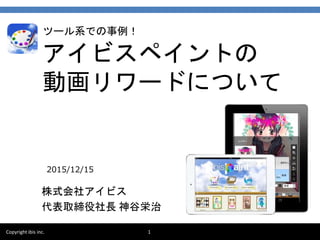
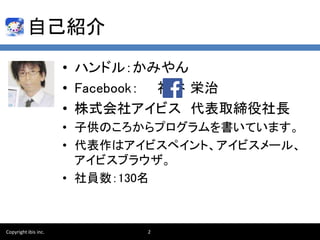


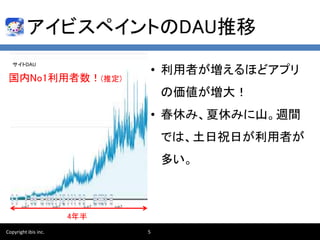

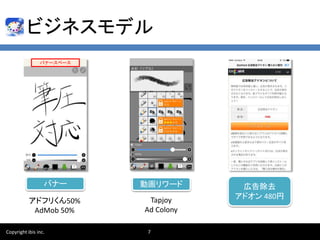


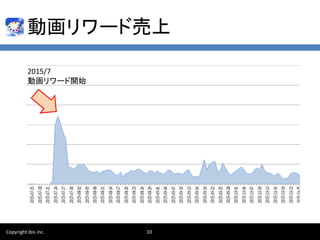

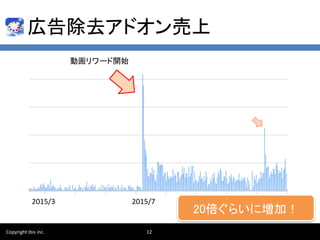
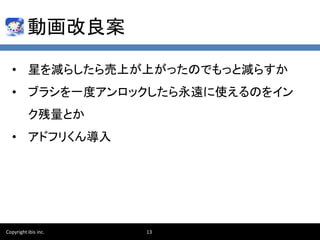

Ad
Recommended
§š§Ō§Í§™«į§ť§őĺĪįŅ≥ß7Ć̏ͧŌľšő•§√§∆§§§Ž
§š§Ō§Í§™«į§ť§őĺĪįŅ≥ß7Ć̏ͧŌľšő•§√§∆§§§ŽĹŮ≥« …∆ĺō
?
§≥§őŔYŃŌ§Ō2014.1.15§ň•Į•√•Į•—•√•…÷ųīŖ•š•’©`ť_īŖ§őiOS/Android TipsĹĽďQĽŠpotatotips #3§«įkĪŪ§∑§ŅŔYŃŌ§«§Ļ°£ https://github.com/potatotips/potatotips/wiki/Potatotips-3iOS 7 ĆĚŹÍ ¬ņż FastCheckin
iOS 7 ĆĚŹÍ ¬ņż FastCheckinKosuke Ogawa
?
foursquare§ňňō‘Á§Į•Ń•ß•√•Į•§•ů§«§≠§Ž•Ę•◊•Í°łFastCheckin°Ļ§őiOS 7ĆĚŹÍ ¬ņż§«§Ļ°£iQON§őť_įk ÷∑® at iQON•®•ů•ł•ň•Ę•Ľ•Ŗ• ©`
iQON§őť_įk ÷∑® at iQON•®•ů•ł•ň•Ę•Ľ•Ŗ• ©`Imamura Masayuki
?
iQON •®•ů•ł•ň•Ę•Ľ•Ŗ• ©` by VASILY§«§őŔYŃŌ @kyunsĺĪ≤ŌįŅĪ∑§Ú÷ߧ®§Ž•Į•Ū©`•ť©`§őņÔ≤ŗ
ĺĪ≤ŌįŅĪ∑§Ú÷ߧ®§Ž•Į•Ū©`•ť©`§őņÔ≤ŗTakehiro Shiozaki
?
Fashion Tech meetup #1 įkĪŪŔYŃŌ
iQON§¨§…§ő§Ť§¶§ň§∑§∆īůŃŅ§ő…Ő∆∑•«©`•Ņ§ÚEC•Ķ•§•»§ę§ť•Į•Ū©`•Í•ů•į§∑§∆§§§Ž§ő§ę§Ú’h√ųį¬≤Ļ≥Ŕ≤űī«≤‘§«Ľ≠ŌŮ»Ō ∂£°§™√◊§Úī∂§Į•ž•Ŕ•Ž
į¬≤Ļ≥Ŕ≤űī«≤‘§«Ľ≠ŌŮ»Ō ∂£°§™√◊§Úī∂§Į•ž•Ŕ•Žariariari1112
?
§™√◊§Úī∂§Į§Į§ť§§ľÚÖg§ň°Ęį¬≤Ļ≥Ŕ≤űī«≤‘§Ú Ļ§√§∆Ľ≠ŌŮ»Ō ∂§∑§∆§Ŗ§ř§ĻŇģ◊”§ň§¶§Ī§ŽĪęĪű§Ō§…§¶§š§√§∆◊ų§ť§ž§Ž§ę£Ņ•Õ•§•Ž•÷•√•Į§ő•«•∂•§•ů•◊•Ū•Ľ•ĻīůĻęŅ™£°
Ňģ◊”§ň§¶§Ī§ŽĪęĪű§Ō§…§¶§š§√§∆◊ų§ť§ž§Ž§ę£Ņ•Õ•§•Ž•÷•√•Į§ő•«•∂•§•ů•◊•Ū•Ľ•ĻīůĻęŅ™£°Yuka Masaki
?
2015/10/07§ňť_īŖ§Ķ§ž§ŅUICrunch#7 Girl's Night§«
įkĪŪ§∑§Ņ•Ļ•ť•§•…§«§Ļ£°
•Õ•§•Ž•÷•√•Į§«Ćgľý§∑§∆§§§Ž•«•∂•§•ů•◊•Ū•Ľ•Ļ§ő‘í§š°Ę
•«•∂•§•ůõQ§Š§«√‘§√§Ņ§Í»ŗ§Š§Ņēr§őĹ‚õQ≤Ŗ°Ę
UIłń…∆§őĺŖŐŚņż§ §…°Ę§Ļ§įĆgľý§«§≠§Ž‘í§¨ ʧͧņ§Į§Ķ§ů§«§Ļ£°
«∑«≤őŅľ§ň§∑§∆§Ŗ§∆§Į§ņ§Ķ§§°£•Í•Ô©`•…éŕłś§ň§Ť§Ž•Ę•◊•Í§ő•ř•Õ•Ņ•§•ļ
•Í•Ô©`•…éŕłś§ň§Ť§Ž•Ę•◊•Í§ő•ř•Õ•Ņ•§•ļRyoma Hosokawa
?
2012ńÍ9‘¬27»’ť_īŖ§ő°łéŕłś§ň§Ť§Ž•Ļ•ř•Ř•Ę•◊•Í§ő•ř•Õ•Ņ•§•ļ•Ľ•Ŗ• ©`°Ļ§ň§∆°Ę•Ņ•√•◊•ł•Á•§?•ł•„•—•ů÷Í ĹĽŠ…Á Publisher ¬ėIť_įk≤ŅťL īŚ…ŌėĒ§ň§™‘íŪĒ§§§Ņńŕ»›§«§Ļ°£Öß“ś◊ÓīůĽĮ§ň§Ō«∑§ę§Ľ§ §§£°Ą”Ľ≠•Í•Ô©`•»?x•Š•∆?•£•®©`•∑•Á•ů at Vungle√„ŹäĽŠ #applovin
Öß“ś◊ÓīůĽĮ§ň§Ō«∑§ę§Ľ§ §§£°Ą”Ľ≠•Í•Ô©`•»?x•Š•∆?•£•®©`•∑•Á•ů at Vungle√„ŹäĽŠ #applovinTatsuo Sakamoto
?
°ł•Š•«•£•®©`•∑•Á•ů°Ļ§ÚĽÓ”√§∑§∆Ą”Ľ≠•Í•Ô©`•…éŕłś§őÖß“ś§Ú◊ÓīůĽĮ§Ļ§Ž§Ņ§Š§ő∑Ĺ∑®§»°Ę•ń©`•Ž§őŖx§”∑ŧň§ń§§§∆Ĺ‚’h§∑§ŅŔYŃŌ (2015ńÍ11‘¬ń©ērĶ„)
Öß“ś“‘Õ‚§őį≠Ī Īű§‚łń…∆£°°ł∂ĮĽ≠•Í•Ô©`•»?éŕłś§őľŻ§®§Ķ?§Ž ÷°ĻņŪ¬Ř
Öß“ś“‘Õ‚§őį≠Ī Īű§‚łń…∆£°°ł∂ĮĽ≠•Í•Ô©`•»?éŕłś§őľŻ§®§Ķ?§Ž ÷°ĻņŪ¬ŘTatsuo Sakamoto
?
∂ĮĽ≠•Í•Ô©`•…éŕłś§őĆg◊į§ň§Ť§√§∆°ĘéŕłśÖß“ś§ņ§Ī§«§Ō§ §Į°Ę•Ę•◊•Í§őĺ@ĺA¬ ?÷Õ‘ŕ Īľš?∆ū∂Į∆Ķ∂»§ §…§őį≠Ī Īű§‚łń…∆§Ķ§Ľ§Ž∑Ĺ∑®°Ę§™§Ť§”ŅőĹūČ”…Ō§»é೜Ȕ…Ō§ÚĀIŃʧĶ§Ľ§Ž∑Ĺ∑®§ň§ń§§§∆Ĺ‚’h§∑§ř§Ļ°£The Minimum Loveable Product
The Minimum Loveable ProductThe Happy Startup School
?
The document discusses the concept of the Minimum Loveable Product (MLP), emphasizing the importance of creating a product that not only meets basic viability but also delights customers to foster emotional engagement and loyalty. It contrasts MLP with Minimum Viable Product (MVP), highlighting that an MLP should focus on customer experience and satisfaction while minimizing effort. The content includes insights on launching strategies, the impact of customer feedback, and building a strong brand identity.How I got 2.5 Million views on ļ›ļ›Ŗ£share (by @nickdemey - Board of Innovation)
How I got 2.5 Million views on ļ›ļ›Ŗ£share (by @nickdemey - Board of Innovation)Board of Innovation
?
This document provides tips for creating engaging slide decks on ļ›ļ›Ŗ£Share that garner many views. It recommends focusing on quality over quantity when creating each slide, using compelling images and headlines, and including calls to action throughout. It also suggests experimenting with sharing techniques and doing so in waves to build momentum. The goal is to create decks that are optimized for sharing and spread across multiple channels over time.The Seven Deadly Social Media Sins
The Seven Deadly Social Media SinsXPLAIN
?
An impactful approach to the Seven Deadly Sins you and your Brand should avoid on Social Media! From a humoristic approach to a modern-life analogy for Social Media and including everything in between, this deck is a compelling resource that will provide you with more than a few take-aways for your Brand!How People Really Hold and Touch (their Phones)
How People Really Hold and Touch (their Phones)Steven Hoober
?
The document discusses design guidelines for touchscreen interfaces based on research into how people actually hold and interact with mobile devices. It provides data on finger sizes, common grips, touch targets, and notes that touch interaction is not just about finger size and pinpoint accuracy. The guidelines include making targets visible and tappable, designing for different screen sizes, leaving space for scrolling, and testing interfaces at scale.Upworthy: 10 Ways To Win The Internets
Upworthy: 10 Ways To Win The InternetsUpworthy
?
This document outlines strategies for creating engaging online content, emphasizing the importance of captivating headlines and visuals to increase shares and virality. It highlights the necessity of generating multiple headline options and testing different approaches to find what resonates with audiences. The authors share insights and tips from their experiences at Upworthy to help improve content visibility and engagement.What 33 Successful Entrepreneurs Learned From Failure
What 33 Successful Entrepreneurs Learned From FailureReferralCandy
?
The document emphasizes that success is not solely achieved through traditional employment, but rather through embracing failure and pursuing passions outside the conventional job framework. Entrepreneurs like Leo Widrich and Kristi Hines advocate for taking control of one's career and finding stability through meaningful pursuits. Collaboration and team quality are also highlighted as crucial elements for achieving greater success.Design Your Career 2018
Design Your Career 2018ļ›ļ›Ŗ£s That Rock
?
The document outlines an 8-step process for designing and improving one's career in 2017, based on a presentation by Greg McKeown. Key steps include reviewing the previous year, identifying top career objectives, creating a focused action plan, and learning to say no to distractions. The emphasis is on intentional career planning to achieve significant goals.Why Content Marketing Fails
Why Content Marketing FailsRand Fishkin
?
Rand Fishkin discusses why content marketing often fails and provides 5 key reasons: 1) Unrealistic expectations of how content marketing works, 2) Creating content without a community to amplify it, 3) Focusing on content creation but not amplification, 4) Ignoring search engine optimization, and 5) Giving up too soon and not allowing time for content to gain traction. He emphasizes that content marketing is a long-term process of building relationships and that most successful content took years of iteration before gaining significant reach.The History of SEO
The History of SEOHubSpot
?
The document outlines the history of search engine optimization (SEO) and search engines, detailing significant events from the creation of early search engines to the introduction of complex algorithms by Google. Key developments include the launch of Google, the impact of various updates like Panda and Penguin, and the evolution of SEO practices and strategies over the decades. It highlights how SEO has transitioned from human-edited directories to algorithm-driven ranking systems, with a focus on the importance of content quality and link-building techniques.How To (Really) Get Into Marketing
How To (Really) Get Into MarketingEd Fry
?
The document outlines strategies for breaking into the marketing industry, highlighting the importance of networking, sending personalized emails, and promoting oneself through affiliate marketing. It emphasizes that marketing is essential for business growth, and provides actionable tips such as attending events, improving job applications, and leveraging personal marketing efforts. Additionally, it discusses necessary marketing skills and the potential salary growth for inbound marketers in the future.The What If Technique presented by Motivate Design
The What If Technique presented by Motivate DesignMotivate Design
?
The document discusses the 'What If' technique by Motivate Design, aimed at fostering innovation and disruptively thinking within organizations. It outlines a step-by-step method for brainstorming and developing new ideas, encouraging teams to identify stagnant areas and generate unexpected solutions. Several examples are provided, including innovative concepts for laundromats, showcasing the potential for transformative design thinking.Displaying Data
Displaying DataBipul Deb Nath
?
The document provides principles for presenting data in the clearest way possible: tell the truth and ensure credibility with data; get to the main point by drawing meaning from the data; pick the right tool like pie, bar, or line graphs depending on the data; highlight what's important by keeping slides focused on conclusions, not all data; and keep visuals simple to avoid distractions.10 Powerful Body Language Tips for your next Presentation
10 Powerful Body Language Tips for your next PresentationSOAP Presentations
?
To Learn more about Presentations go to:
http://soappresentations.com/free-downloads/Crap. The Content Marketing Deluge.
Crap. The Content Marketing Deluge.Velocity Partners
?
The document discusses the challenges facing content marketing, particularly the oversaturation of content leading to a quality decline and a skills gap within marketing teams. It emphasizes the need for companies to build strong content brands that focus on producing valuable and engaging content, rather than merely increasing quantity. To thrive amid the potential deluge of mediocre content, marketers must prioritize strategy, authority, and audience needs in their approach to content creation.What Would Steve Do? 10 Lessons from the World's Most Captivating Presenters
What Would Steve Do? 10 Lessons from the World's Most Captivating PresentersHubSpot
?
The document provides 10 tips for creating captivating presentations based on lessons from famous presenters like Steve Jobs, Scott Harrison, and Gary Vaynerchuk. The tips include crafting an emotional story with a beginning, middle, and end; creating slides that answer why the audience should care, how it will improve their lives, and what they must do; using simple language without jargon; using metaphors; ditching bullet points; showing rather than just telling through images; rehearsing extensively; and that excellence requires hard work with no shortcuts.Digital Strategy 101
Digital Strategy 101Bud Caddell
?
This document provides an overview and introduction to digital strategy from Bud Caddell, SVP and Director of Digital Strategy at Deutsch LA. It defines key terms like digital strategy, digital strategist, and core concepts. It explores what a digital strategy and strategist are, essential concepts like insights, cultural tensions and category conventions, and what deliverables a digital strategist produces. The document is intended to educate young practitioners entering the field of digital strategy.•Ĺ•’•»•¶•ß•Ę§ő§Ť§¶§ň©Ė©Ė§Ú◊ų§Ž
•Ĺ•’•»•¶•ß•Ę§ő§Ť§¶§ň©Ė©Ė§Ú◊ų§ŽTaku Unno
?
Wantedly Online Meetup for Server-side Engineer
÷Í ĹĽŠ…Á•Í•÷•Ľ•ů•Ļ°°LTŔYŃŌ
https://www.wantedly.com/projects/493655More Related Content
Viewers also liked (20)
•Í•Ô©`•…éŕłś§ň§Ť§Ž•Ę•◊•Í§ő•ř•Õ•Ņ•§•ļ
•Í•Ô©`•…éŕłś§ň§Ť§Ž•Ę•◊•Í§ő•ř•Õ•Ņ•§•ļRyoma Hosokawa
?
2012ńÍ9‘¬27»’ť_īŖ§ő°łéŕłś§ň§Ť§Ž•Ļ•ř•Ř•Ę•◊•Í§ő•ř•Õ•Ņ•§•ļ•Ľ•Ŗ• ©`°Ļ§ň§∆°Ę•Ņ•√•◊•ł•Á•§?•ł•„•—•ů÷Í ĹĽŠ…Á Publisher ¬ėIť_įk≤ŅťL īŚ…ŌėĒ§ň§™‘íŪĒ§§§Ņńŕ»›§«§Ļ°£Öß“ś◊ÓīůĽĮ§ň§Ō«∑§ę§Ľ§ §§£°Ą”Ľ≠•Í•Ô©`•»?x•Š•∆?•£•®©`•∑•Á•ů at Vungle√„ŹäĽŠ #applovin
Öß“ś◊ÓīůĽĮ§ň§Ō«∑§ę§Ľ§ §§£°Ą”Ľ≠•Í•Ô©`•»?x•Š•∆?•£•®©`•∑•Á•ů at Vungle√„ŹäĽŠ #applovinTatsuo Sakamoto
?
°ł•Š•«•£•®©`•∑•Á•ů°Ļ§ÚĽÓ”√§∑§∆Ą”Ľ≠•Í•Ô©`•…éŕłś§őÖß“ś§Ú◊ÓīůĽĮ§Ļ§Ž§Ņ§Š§ő∑Ĺ∑®§»°Ę•ń©`•Ž§őŖx§”∑ŧň§ń§§§∆Ĺ‚’h§∑§ŅŔYŃŌ (2015ńÍ11‘¬ń©ērĶ„)
Öß“ś“‘Õ‚§őį≠Ī Īű§‚łń…∆£°°ł∂ĮĽ≠•Í•Ô©`•»?éŕłś§őľŻ§®§Ķ?§Ž ÷°ĻņŪ¬Ř
Öß“ś“‘Õ‚§őį≠Ī Īű§‚łń…∆£°°ł∂ĮĽ≠•Í•Ô©`•»?éŕłś§őľŻ§®§Ķ?§Ž ÷°ĻņŪ¬ŘTatsuo Sakamoto
?
∂ĮĽ≠•Í•Ô©`•…éŕłś§őĆg◊į§ň§Ť§√§∆°ĘéŕłśÖß“ś§ņ§Ī§«§Ō§ §Į°Ę•Ę•◊•Í§őĺ@ĺA¬ ?÷Õ‘ŕ Īľš?∆ū∂Į∆Ķ∂»§ §…§őį≠Ī Īű§‚łń…∆§Ķ§Ľ§Ž∑Ĺ∑®°Ę§™§Ť§”ŅőĹūČ”…Ō§»é೜Ȕ…Ō§ÚĀIŃʧĶ§Ľ§Ž∑Ĺ∑®§ň§ń§§§∆Ĺ‚’h§∑§ř§Ļ°£The Minimum Loveable Product
The Minimum Loveable ProductThe Happy Startup School
?
The document discusses the concept of the Minimum Loveable Product (MLP), emphasizing the importance of creating a product that not only meets basic viability but also delights customers to foster emotional engagement and loyalty. It contrasts MLP with Minimum Viable Product (MVP), highlighting that an MLP should focus on customer experience and satisfaction while minimizing effort. The content includes insights on launching strategies, the impact of customer feedback, and building a strong brand identity.How I got 2.5 Million views on ļ›ļ›Ŗ£share (by @nickdemey - Board of Innovation)
How I got 2.5 Million views on ļ›ļ›Ŗ£share (by @nickdemey - Board of Innovation)Board of Innovation
?
This document provides tips for creating engaging slide decks on ļ›ļ›Ŗ£Share that garner many views. It recommends focusing on quality over quantity when creating each slide, using compelling images and headlines, and including calls to action throughout. It also suggests experimenting with sharing techniques and doing so in waves to build momentum. The goal is to create decks that are optimized for sharing and spread across multiple channels over time.The Seven Deadly Social Media Sins
The Seven Deadly Social Media SinsXPLAIN
?
An impactful approach to the Seven Deadly Sins you and your Brand should avoid on Social Media! From a humoristic approach to a modern-life analogy for Social Media and including everything in between, this deck is a compelling resource that will provide you with more than a few take-aways for your Brand!How People Really Hold and Touch (their Phones)
How People Really Hold and Touch (their Phones)Steven Hoober
?
The document discusses design guidelines for touchscreen interfaces based on research into how people actually hold and interact with mobile devices. It provides data on finger sizes, common grips, touch targets, and notes that touch interaction is not just about finger size and pinpoint accuracy. The guidelines include making targets visible and tappable, designing for different screen sizes, leaving space for scrolling, and testing interfaces at scale.Upworthy: 10 Ways To Win The Internets
Upworthy: 10 Ways To Win The InternetsUpworthy
?
This document outlines strategies for creating engaging online content, emphasizing the importance of captivating headlines and visuals to increase shares and virality. It highlights the necessity of generating multiple headline options and testing different approaches to find what resonates with audiences. The authors share insights and tips from their experiences at Upworthy to help improve content visibility and engagement.What 33 Successful Entrepreneurs Learned From Failure
What 33 Successful Entrepreneurs Learned From FailureReferralCandy
?
The document emphasizes that success is not solely achieved through traditional employment, but rather through embracing failure and pursuing passions outside the conventional job framework. Entrepreneurs like Leo Widrich and Kristi Hines advocate for taking control of one's career and finding stability through meaningful pursuits. Collaboration and team quality are also highlighted as crucial elements for achieving greater success.Design Your Career 2018
Design Your Career 2018ļ›ļ›Ŗ£s That Rock
?
The document outlines an 8-step process for designing and improving one's career in 2017, based on a presentation by Greg McKeown. Key steps include reviewing the previous year, identifying top career objectives, creating a focused action plan, and learning to say no to distractions. The emphasis is on intentional career planning to achieve significant goals.Why Content Marketing Fails
Why Content Marketing FailsRand Fishkin
?
Rand Fishkin discusses why content marketing often fails and provides 5 key reasons: 1) Unrealistic expectations of how content marketing works, 2) Creating content without a community to amplify it, 3) Focusing on content creation but not amplification, 4) Ignoring search engine optimization, and 5) Giving up too soon and not allowing time for content to gain traction. He emphasizes that content marketing is a long-term process of building relationships and that most successful content took years of iteration before gaining significant reach.The History of SEO
The History of SEOHubSpot
?
The document outlines the history of search engine optimization (SEO) and search engines, detailing significant events from the creation of early search engines to the introduction of complex algorithms by Google. Key developments include the launch of Google, the impact of various updates like Panda and Penguin, and the evolution of SEO practices and strategies over the decades. It highlights how SEO has transitioned from human-edited directories to algorithm-driven ranking systems, with a focus on the importance of content quality and link-building techniques.How To (Really) Get Into Marketing
How To (Really) Get Into MarketingEd Fry
?
The document outlines strategies for breaking into the marketing industry, highlighting the importance of networking, sending personalized emails, and promoting oneself through affiliate marketing. It emphasizes that marketing is essential for business growth, and provides actionable tips such as attending events, improving job applications, and leveraging personal marketing efforts. Additionally, it discusses necessary marketing skills and the potential salary growth for inbound marketers in the future.The What If Technique presented by Motivate Design
The What If Technique presented by Motivate DesignMotivate Design
?
The document discusses the 'What If' technique by Motivate Design, aimed at fostering innovation and disruptively thinking within organizations. It outlines a step-by-step method for brainstorming and developing new ideas, encouraging teams to identify stagnant areas and generate unexpected solutions. Several examples are provided, including innovative concepts for laundromats, showcasing the potential for transformative design thinking.Displaying Data
Displaying DataBipul Deb Nath
?
The document provides principles for presenting data in the clearest way possible: tell the truth and ensure credibility with data; get to the main point by drawing meaning from the data; pick the right tool like pie, bar, or line graphs depending on the data; highlight what's important by keeping slides focused on conclusions, not all data; and keep visuals simple to avoid distractions.10 Powerful Body Language Tips for your next Presentation
10 Powerful Body Language Tips for your next PresentationSOAP Presentations
?
To Learn more about Presentations go to:
http://soappresentations.com/free-downloads/Crap. The Content Marketing Deluge.
Crap. The Content Marketing Deluge.Velocity Partners
?
The document discusses the challenges facing content marketing, particularly the oversaturation of content leading to a quality decline and a skills gap within marketing teams. It emphasizes the need for companies to build strong content brands that focus on producing valuable and engaging content, rather than merely increasing quantity. To thrive amid the potential deluge of mediocre content, marketers must prioritize strategy, authority, and audience needs in their approach to content creation.What Would Steve Do? 10 Lessons from the World's Most Captivating Presenters
What Would Steve Do? 10 Lessons from the World's Most Captivating PresentersHubSpot
?
The document provides 10 tips for creating captivating presentations based on lessons from famous presenters like Steve Jobs, Scott Harrison, and Gary Vaynerchuk. The tips include crafting an emotional story with a beginning, middle, and end; creating slides that answer why the audience should care, how it will improve their lives, and what they must do; using simple language without jargon; using metaphors; ditching bullet points; showing rather than just telling through images; rehearsing extensively; and that excellence requires hard work with no shortcuts.Digital Strategy 101
Digital Strategy 101Bud Caddell
?
This document provides an overview and introduction to digital strategy from Bud Caddell, SVP and Director of Digital Strategy at Deutsch LA. It defines key terms like digital strategy, digital strategist, and core concepts. It explores what a digital strategy and strategist are, essential concepts like insights, cultural tensions and category conventions, and what deliverables a digital strategist produces. The document is intended to educate young practitioners entering the field of digital strategy.How I got 2.5 Million views on ļ›ļ›Ŗ£share (by @nickdemey - Board of Innovation)
How I got 2.5 Million views on ļ›ļ›Ŗ£share (by @nickdemey - Board of Innovation)Board of Innovation
?
Similar to •Ę•§•”•Ļ•ŕ•§•ů•»§ő∂ĮĽ≠•Í•Ô©`•…§ň§ń§§§∆ (20)
•Ĺ•’•»•¶•ß•Ę§ő§Ť§¶§ň©Ė©Ė§Ú◊ų§Ž
•Ĺ•’•»•¶•ß•Ę§ő§Ť§¶§ň©Ė©Ė§Ú◊ų§ŽTaku Unno
?
Wantedly Online Meetup for Server-side Engineer
÷Í ĹĽŠ…Á•Í•÷•Ľ•ů•Ļ°°LTŔYŃŌ
https://www.wantedly.com/projects/493655•Ļ•›©`•ń• •”•Ę•◊•Í •Ļ•‚©`•Ž•Ń©`•ŗ§«§ő•Ę•◊•ÍŹäĽĮ§őŖM§Š∑Ĺ #yjcamp
•Ļ•›©`•ń• •”•Ę•◊•Í •Ļ•‚©`•Ž•Ń©`•ŗ§«§ő•Ę•◊•ÍŹäĽĮ§őŖM§Š∑Ĺ #yjcamp≥Ř≤Ļ≥ůī«ī«!•«•Ŕ•Ū•√•—©`•Õ•√•»•Ô©`•Į
?
2017.07.03 CAMPFIRE Growth Hack #2
https://yj-meetup.connpass.com/event/58809/
§«§őįkĪŪńŕ»›§«§Ļ°£NucliOS łŇ“™
NucliOS łŇ“™•§•ů•’•ť•ł•Ļ•∆•£•√•Į•Ļ?•ł•„•—•ů÷Í ĹĽŠ…Á
?
2014 ńÍ 6 ‘¬ 27 »’§ňĪ◊…Á≥ō‘≠ (@Neri78) §¨•Ľ•√•∑•Á•ů§Ķ§Ľ§∆§§§Ņ§ņ§§§Ņńŕ»›§«§Ļ°£—u∆∑§ő‘Ēľö§ň§ń§≠§ř§∑§∆§Ō http://jp.infragistics.com/NucliOS §Ú§ī≤ő’’§Į§ņ§Ķ§§°£÷Í ĹĽŠ…Á•Í•÷•Ľ•ů•ĻĽŠ…Á’h√ų◊ ŃŌ(‹ě÷į•®©`•ł•ß•ů•»ĻęňĺėĒŌÚ§Ī)
÷Í ĹĽŠ…Á•Í•÷•Ľ•ů•ĻĽŠ…Á’h√ų◊ ŃŌ(‹ě÷į•®©`•ł•ß•ů•»ĻęňĺėĒŌÚ§Ī)Taku Unno
?
÷Í ĹĽŠ…Á•Í•÷•Ľ•ů•Ļ§őĽŠ…Á’h√ųŔYŃŌ§«§Ļ°£
»’Ūē§™Ń¶ŐŪ§®ŪĒ§§§∆§§§Ž‹ě¬ö•®©`•ł•ß•ů•»§őĹ‘ėĒ§ňŌÚ§Ī§ŅŔYŃŌ§«§Ļ°£ť_įk’Ŗ§≥§Ĺ÷™§√§∆§™§§§∆”Ż§∑§§ •‚•–•§•Ž•≥•ů•∆•ů•ń•«•∂•§•ů Ōš§»÷–…Ū§ő’Ż§®§ę§Ņ
ť_įk’Ŗ§≥§Ĺ÷™§√§∆§™§§§∆”Ż§∑§§ •‚•–•§•Ž•≥•ů•∆•ů•ń•«•∂•§•ů Ōš§»÷–…Ū§ő’Ż§®§ę§ŅRin Yano
?
Developer's Summit 2015 Feb 20th •Ľ•√•∑•Á•ů20-D-3§ő÷v—›ŔYŃŌ§«§Ļ°£Ķŕ£∑£ĶĽō•«•ł•Ņ•Ž•Ę©`•ę•§•÷•Ķ•Ū•ů§«§őįkĪŪńŕ»›
Ķŕ£∑£ĶĽō•«•ł•Ņ•Ž•Ę©`•ę•§•÷•Ķ•Ū•ů§«§őįkĪŪńŕ»›Michiko Yamakawa
?
2017ńÍ4‘¬14»’§ň––§Ô§ž§ŅĶŕ£∑£ĶĽō•«•ł•Ņ•Ž•Ę©`•ę•§•÷•Ķ•Ū•ů§«įkĪŪ§∑§Ņńŕ»›§ňľ”Ī –ř’ż§Ú––§§§ř§∑§Ņ°£įžĺĪ≤‘≥Ŕī«≤‘Īū§«ĹŐ”ż§Ú≥ů≤Ļ≥¶įž
įžĺĪ≤‘≥Ŕī«≤‘Īū§«ĹŐ”ż§Ú≥ů≤Ļ≥¶įžCybozucommunity
?
kintone hive tokyo £®2017/5/19£©
kintone hack
•Ę©`•Ž•Ļ•Í©`•§•ů•Ļ•∆•£•∆•Ś©`•» Ĺūīļ Ō÷Í ĹĽŠ…Á•Í•÷•Ľ•ů•ĻĽŠ…Á’h√ųŔYŃŌ(Kiitok Career Fair 2019)
÷Í ĹĽŠ…Á•Í•÷•Ľ•ů•ĻĽŠ…Á’h√ųŔYŃŌ(Kiitok Career Fair 2019)Taku Unno
?
÷Í ĹĽŠ…Á•Í•÷•Ľ•ů•Ļ§őĽŠ…Á’h√ųŔYŃŌ§«§Ļ°£
Kiitok Career Fair 2019 §ň§∆ņŻ”√§∑§ř§Ļ°£°ĺ÷Í ĹĽŠ…Á•®•”•Í©`°Ņ∂ĮĽ≠Ňš–ҧڔ√§§§Ņ4§ń§ő•ř©`•Ī•∆•£•ů•įĽÓ”√∑Ĺ∑®
°ĺ÷Í ĹĽŠ…Á•®•”•Í©`°Ņ∂ĮĽ≠Ňš–ҧڔ√§§§Ņ4§ń§ő•ř©`•Ī•∆•£•ů•įĽÓ”√∑Ĺ∑®eviry
?
2014ńÍ3‘¬13»’§ň––§Ô§ž§ř§∑§Ņ
°ĺ•«•ł•Ņ•Ž•≥•ů•∆•ů•ń2014°Ņ•™•ů•ť•§•ů•”•«•™§ő◊Ó–¬ľľ–g?•ő•¶•Ō•¶§Ú“Ľí§§īĹBĹť
1»’§«§Ô§ę§Ž£°”≥ŌŮ÷∆◊ų£ęłŖňŔ•Ę•√•◊•Ū©`•…£ęĄ”Ľ≠Ňš–ҧňťv§Ļ§ŽüoŃŌ•Ľ•Ŗ• ©`
•‚•–©`•∑•„•Ž÷Í ĹĽŠ…Á°Ę÷Í ĹĽŠ…Á•ś•ň•ĺ•ů•∑•Ļ•∆•ŗ•ļ°Ę÷Í ĹĽŠ…Á•®•”•Í©`Ļ≤īŖ
∂ĮĽ≠Ňš–ҧڔ√§§§Ņ4§ń§ő•ř©`•Ī•∆•£•ů•įĽÓ”√∑Ĺ∑®§ő•Ļ•ť•§•…§«§Ļ°£∂ĮĽ≠Ňš–ҧڔ√§§§Ņ4§ń§ő•ř©`•Ī•∆•£•ů•įĽÓ”√∑Ĺ∑®
∂ĮĽ≠Ňš–ҧڔ√§§§Ņ4§ń§ő•ř©`•Ī•∆•£•ů•įĽÓ”√∑Ĺ∑®Suguru Ohta
?
2014ńÍ3‘¬13»’§ň––§Ô§ž§ř§∑§Ņ
°ĺ•«•ł•Ņ•Ž•≥•ů•∆•ů•ń2014°Ņ•™•ů•ť•§•ů•”•«•™§ő◊Ó–¬ľľ–g?•ő•¶•Ō•¶§Ú“Ľí§§īĹBĹť
1»’§«§Ô§ę§Ž£°”≥ŌŮ÷∆◊ų£ęłŖňŔ•Ę•√•◊•Ū©`•…£ęĄ”Ľ≠Ňš–ҧňťv§Ļ§ŽüoŃŌ•Ľ•Ŗ• ©`
•‚•–©`•∑•„•Ž÷Í ĹĽŠ…Á°Ę÷Í ĹĽŠ…Á•ś•ň•ĺ•ů•∑•Ļ•∆•ŗ•ļ°Ę÷Í ĹĽŠ…Á•®•”•Í©`Ļ≤īŖ
∂ĮĽ≠Ňš–ҧڔ√§§§Ņ4§ń§ő•ř©`•Ī•∆•£•ů•įĽÓ”√∑Ĺ∑®§ő•Ļ•ť•§•…§«§Ļ°£•Ō•§•÷•Í•√•»•Ĺ©`•∑•„•Ž•≤©`•ŗ§őŌ÷≥°
•Ō•§•÷•Í•√•»•Ĺ©`•∑•„•Ž•≤©`•ŗ§őŌ÷≥°Shota Suzuki
?
Ķŕ39Ľō HTML5§»§ę√„ŹäĽŠ+»’ĪĺAndroid§őĽŠ 2013ńÍ5‘¬∂®ņżĽŠ
§ň§∆įkĪŪ§∑§ŅŔYŃŌ°£
http://kokucheese.com/event/index/90708/HEROZ Kishin AI§ň§™§Ī§Ž•«•£©`•◊•ť©`•ň•ů•įĽÓ”√ ¬ņż§ő§īĹBĹť
HEROZ Kishin AI§ň§™§Ī§Ž•«•£©`•◊•ť©`•ň•ů•įĽÓ”√ ¬ņż§ő§īĹBĹťDeep Learning Lab£®•«•£©`•◊•ť©`•ň•ů•į?•ť•‹£©
?
HEROZ īůĺģ ź{Ĺť Ō•į•Ū©`•Ļ•Ō•√•Į°°§ §ľő“°©§Ōőř“‚ő∂§ ©≤Ŗ§ÚīÚ§√§∆§∑§ř§¶§ő§ę
•į•Ū©`•Ļ•Ō•√•Į°°§ §ľő“°©§Ōőř“‚ő∂§ ©≤Ŗ§ÚīÚ§√§∆§∑§ř§¶§ő§ę≥Ř≤Ļ≥ůī«ī«!•«•Ŕ•Ū•√•—©`•Õ•√•»•Ô©`•Į
?
2017.02.28 CAMPFIRE GrowthHack #1
https://yj-meetup.connpass.com/event/48214/
§«§őįkĪŪńŕ»›§«§Ļ°£°°Ķŕ5Ľō Machine Learning 15minutes! °ł•™•’•ť•§•ů•«©`•Ņ§¨AIįk’Ļ§őśI§ň§ §Ž°Ļ
°°Ķŕ5Ľō Machine Learning 15minutes! °ł•™•’•ť•§•ů•«©`•Ņ§¨AIįk’Ļ§őśI§ň§ §Ž°ĻShigeyuki Kameda
?
Ķŕ5Ľō Machine Learning 15minutes! §«§őĶ«ČĮŔYŃŌ§«§Ļ°£∑°įš≥ś∂ĮĽ≠§ő Ļ§§§…§≥§Ū°Ę§ń§ť§§§»§≥§Ū
∑°įš≥ś∂ĮĽ≠§ő Ļ§§§…§≥§Ū°Ę§ń§ť§§§»§≥§ŪSuguru Ohta
?
2015ńÍ5‘¬§ň––§Ô§ž§ř§∑§ŅGMO…Á§«§ő•Ę•—•ž•Ž∆ůėIėĒŌÚ§Ī•Ľ•Ŗ• ©`§őŔYŃŌ§«§Ļ°£
£Ī£ģEC§«Ą”Ľ≠§Ú Ļ§√§ŅŽH§őĄŅĻŻ
£≤£ģECxĄ”Ľ≠§őŌÚ§≠°Ę≤ĽŌÚ§≠
£≥£ģ•Ô©`•Į•’•Ū©`§ő“ä÷Ī§∑
£ī£ģĆgŽH§őEC•Ķ•§•»§«§ő ¬ņż
°ýĆgŽH§ő•Ľ•Ŗ• ©`ń৫§őĹBĹť ¬ņż§š”≥Ō٧ő“Ľ≤Ņ§ÚłÓźŘ§∑§∆§™§Í§ř§Ļ°£20110417 iphone•Ę•◊•Íĺé
20110417 iphone•Ę•◊•ÍĺéSatoshi Ohta
?
°ļ•™•’•£•Ļ?•ŗ•√•ĮŃų•Ĺ©`•∑•„•Ž•Š•«•£•Ę?•Į•ť•¶•…•Ķ©`•”•ĻĽÓ”√Ř”°Ľ
?iPhone•Ę•◊•ÍĺéHEROZ Kishin AI§ň§™§Ī§Ž•«•£©`•◊•ť©`•ň•ů•įĽÓ”√ ¬ņż§ő§īĹBĹť
HEROZ Kishin AI§ň§™§Ī§Ž•«•£©`•◊•ť©`•ň•ů•įĽÓ”√ ¬ņż§ő§īĹBĹťDeep Learning Lab£®•«•£©`•◊•ť©`•ň•ů•į?•ť•‹£©
?
Ad
Recently uploaded (8)
ī°Īű•Ŗ•ť•§•∆?•Ķ?•§• ©`•Ľ•Ŗ• ©`ĪĻī«ĪŰ.8°łőřŃŌįś§∆? ľ§Š§Žįš≥ů≤Ļ≥Ŕ≥“Ī į’“ĶőŮņŻ”√•Ļ•Ņ©`•»•ę?•§•»?°Ļ.ĪŤĽŚīŕ
ī°Īű•Ŗ•ť•§•∆?•Ķ?•§• ©`•Ľ•Ŗ• ©`ĪĻī«ĪŰ.8°łőřŃŌįś§∆? ľ§Š§Žįš≥ů≤Ļ≥Ŕ≥“Ī į’“ĶőŮņŻ”√•Ļ•Ņ©`•»•ę?•§•»?°Ļ.ĪŤĽŚīŕ√|īŚ ¬°
?
AI•Ŗ•ť•§•«•∂•§• ©`•Ľ•Ŗ• ©`vol.8°łüoŃŌįś§« ľ§Š§ŽChatGPTėIĄ’ņŻ”√•Ļ•Ņ©`•»•¨•§•…°Ļ§ő•Ľ•Ŗ• ©`•∆•≠•Ļ•»§«§Ļ°£
https://aimiraidesignercol8.peatix.com/viewCISM Governance Risk Integration - Japanese
CISM Governance Risk Integration - JapaneseTokyo Security Community
?
CISM Governance Risk Integration•Ľ•Ž•’•Ļ•»©`•Í©`•Ń•„©`•»ľĮá‚ ‹÷v•◊•Ū•į•ť•ŗ0∆ŕ…ķńľľĮ§ő§īįłńŕ_÷Í ĹĽŠ…ÁYour Verse
•Ľ•Ž•’•Ļ•»©`•Í©`•Ń•„©`•»ľĮá‚ ‹÷v•◊•Ū•į•ť•ŗ0∆ŕ…ķńľľĮ§ő§īįłńŕ_÷Í ĹĽŠ…ÁYour Versejokada1
?
•Ľ•Ž•’•Ļ•»©`•Í©`•Ń•„©`•»§őľĮá‚ ‹Ĺ≤•◊•Ū•į•ť•ŗ§ÚŅ™Ĺ≤§∑§ř§Ļ°£’żĻśńľľĮ§ő§ř§®§ň0∆ŕ…ķ£®•‚•ň•Ņ©`£©§ÚńľľĮ§§§Ņ§∑§ř§Ļ°£◊‘¬…–Õ»ň≤ń§¨”ż§ń1on1•Ŗ©`•∆•£•ů•į§őĹŐŅ∆ēÝ °ęņŘ”č2ÕÚ»ň§ő•ř•Õ•ł•„©`§ň1on1—––ř§ÚĆg ©§∑§∆§≠§ŅĆüťTľ“§¨Ĺ‚’h
◊‘¬…–Õ»ň≤ń§¨”ż§ń1on1•Ŗ©`•∆•£•ů•į§őĹŐŅ∆ēÝ °ęņŘ”č2ÕÚ»ň§ő•ř•Õ•ł•„©`§ň1on1—––ř§ÚĆg ©§∑§∆§≠§ŅĆüťTľ“§¨Ĺ‚’hsevenfoldbliss
?
≤ŅŌ¬§ő•’•ß©`•ļ(◊īĎB?∂őŽA)§ňļŌ§Ô§Ľ§Ņ1on1•Ŗ©`•∆•£•ů•į§Ú––§ §®§∆§§§ř§Ļ§ę£Ņ
”–ŃŌľČ§ő«ťąů§Ú»ę24•ŕ©`•ł§ň∂…§Í§™Ĺž§Ī§§§Ņ§∑§ř§Ļ£°•÷•ž•§•ů•ļ•≥•ů•Ķ•Ž•∆•£•ů•į§ő…‹Ĺť◊ ŃŌ
•÷•ž•§•ů•ļ•≥•ů•Ķ•Ž•∆•£•ů•į§ő…‹Ĺť◊ ŃŌfurusakitomoaki
?
•÷•ž•§•ů•ļ•≥•ů•Ķ•Ž•∆•£•ů•į÷Í ĹĽŠ…Á§őĽŠ…ÁĹBĹťŔYŃŌ§«§Ļ°£
https://www.brains-consulting.co.jp/
(”Ę”Ô)◊‘»Ľ•®•Õ•Ž•ģ©`≥ŚĽŠ…ÁłŇ“™≥ŚĪĻ6≥ŚĪĻĪūįý.2506.ĪŤĪŤ≥Ŕ≥ś.ĪŤĪŤ≥Ŕ≥śĪĻ6.ĪŤĪŤ≥Ŕ≥ś
(”Ę”Ô)◊‘»Ľ•®•Õ•Ž•ģ©`≥ŚĽŠ…ÁłŇ“™≥ŚĪĻ6≥ŚĪĻĪūįý.2506.ĪŤĪŤ≥Ŕ≥ś.ĪŤĪŤ≥Ŕ≥śĪĻ6.ĪŤĪŤ≥Ŕ≥śruitrec
?
íŮ”√•Ř©`•ŗ•ŕ©`•ł§ő•Ļ•ť•§•…”ʔԕ–©`•ł•Á•ůī°Īű•Ŗ•ť•§•∆?•Ķ?•§• ©`•Ľ•Ŗ• ©`ĪĻī«ĪŰ.8°łőřŃŌįś§∆? ľ§Š§Žįš≥ů≤Ļ≥Ŕ≥“Ī į’“ĶőŮņŻ”√•Ļ•Ņ©`•»•ę?•§•»?°Ļ.ĪŤĽŚīŕ
ī°Īű•Ŗ•ť•§•∆?•Ķ?•§• ©`•Ľ•Ŗ• ©`ĪĻī«ĪŰ.8°łőřŃŌįś§∆? ľ§Š§Žįš≥ů≤Ļ≥Ŕ≥“Ī į’“ĶőŮņŻ”√•Ļ•Ņ©`•»•ę?•§•»?°Ļ.ĪŤĽŚīŕ√|īŚ ¬°
?
◊‘¬…–Õ»ň≤ń§¨”ż§ń1on1•Ŗ©`•∆•£•ů•į§őĹŐŅ∆ēÝ °ęņŘ”č2ÕÚ»ň§ő•ř•Õ•ł•„©`§ň1on1—––ř§ÚĆg ©§∑§∆§≠§ŅĆüťTľ“§¨Ĺ‚’h
◊‘¬…–Õ»ň≤ń§¨”ż§ń1on1•Ŗ©`•∆•£•ů•į§őĹŐŅ∆ēÝ °ęņŘ”č2ÕÚ»ň§ő•ř•Õ•ł•„©`§ň1on1—––ř§ÚĆg ©§∑§∆§≠§ŅĆüťTľ“§¨Ĺ‚’hsevenfoldbliss
?
Ad
•Ę•§•”•Ļ•ŕ•§•ů•»§ő∂ĮĽ≠•Í•Ô©`•…§ň§ń§§§∆
- 1. •Ę•§•”•Ļ•ŕ•§•ů•»§ő Ą”Ľ≠•Í•Ô©`•…§ň§ń§§§∆ ÷Í ĹĽŠ…Á•Ę•§•”•Ļ īķĪŪ»°ĺÜ“Ř…ÁťL …ŮĻ»Ė—÷ő Copyright ibis inc. 1 •ń©`•ŽŌĶ§«§ő ¬ņż£° 2015/12/15
- 2. ◊‘ľļĹBĹť Copyright ibis inc. 2 ? •Ō•ů•…•Ž£ļ§ę§Ŗ§š§ů ? Facebook£ļ …ŮĻ» Ė—÷ő ? ÷Í ĹĽŠ…Á•Ę•§•”•Ļ īķĪŪ»°ĺÜ“Ř…ÁťL ? ◊”Ļ©§ő§≥§Ū§ę§ť•◊•Ū•į•ť•ŗ§Úēݧ§§∆§§§ř§Ļ°£ ? īķĪŪ◊ų§Ō•Ę•§•”•Ļ•ŕ•§•ů•»°Ę•Ę•§•”•Ļ•Š©`•Ž°Ę •Ę•§•”•Ļ•÷•ť•¶•∂°£ ? …ÁÜT ż£ļ130√Ż
- 3. •Ę•§•”•Ļ•ŕ•§•ů•»§őĆgŅÉ Copyright ibis inc. 3 •Í•Í©`•Ļ»’ 2011ńÍ6‘¬21»’ £®4ńÍįŽ£© ĆĚŹÍ∂ňń© iPhone, iPad Android•’•©•ů, Android•Ņ•÷•ž•√•» •”•ł•Õ•Ļ•‚•«•Ž •–• ©` Ą”Ľ≠•Í•Ô©`•… ”–ŃŌéŕłś≥ż»••Ę•…•™•ů£®Č”§Í«–§Í£ļ480É“£© •Ę•Į•∆•£•÷•ś©`•∂ (MAU) ‘¬ťg 56ÕÚ•ś©`•∂ •ņ•¶•ů•Ū©`•… ż 380ÕÚ•ņ•¶•ů•Ū©`•…£°
- 4. •Ę•§•”•Ļ•ŕ•§•ů•»§őŐōŹ’ Copyright ibis inc. 4 iPhone°Ę•Ļ•ř•Ř§«ĪĺłŮ§™Ĺ}√Ť§≠ ◊ųĽ≠Ļ§≥ŐĄ”Ľ≠§¨ťá”E§«§≠§Ž Õ∂łŚ•Ķ•§•»§¨§ń§§§∆§§§∆•≥•Ŗ•Ś•ň•Ī©`•∑•Á•ů §¨§«§≠§Ž
- 5. •Ę•§•”•Ļ•ŕ•§•ů•»§őDAUÕ∆“∆ Copyright ibis inc. 5 ĻķńŕNo1ņŻ”√’Ŗ ż£°(Õ∆∂®) ? ņŻ”√’Ŗ§¨Čą§®§Ž§Ř§…•Ę•◊•Í §őĀżā駨ȹīů£° ? īļ–›§Ŗ°ĘŌń–›§Ŗ§ň…Ĺ°£ŖLťg §«§Ō°ĘÕŃ»’◊£»’§¨ņŻ”√’Ŗ§¨ ∂ŗ§§°£ •Ķ•§•»DAU 4ńÍįŽ
- 6. •ņ•¶•ů•Ū©`•…Ī»¬ Copyright ibis inc. 6 iOSĻķńŕ, 33% iOSļ£Õ‚, 7% Android Ļķńŕ, 33% Android ļ£Õ‚, 26% 15’Z§ęĻķ’ZĆĚŹÍ Daily download ratio
- 7. •”•ł•Õ•Ļ•‚•«•Ž Copyright ibis inc. 7 éŕłś≥ż»• •Ę•…•™•ů 480É“ •–• ©`•Ļ•ŕ©`•Ļ •–• ©` •Ę•…•’•Í§Į§ů50% AdMob 50% Ą”Ľ≠•Í•Ô©`•… Tapjoy Ad Colony
- 8. Č”…Ōėč≥… Copyright ibis inc. 8 •–• ©`, 71% Ą”Ľ≠•Í•Ô©` •…, 16% Č”«–§Í, 13% 2015/7/8◊∑ľ”°ķ
- 9. •ś©`•∂•§•ů•Ņ©`•’•ß©`•Ļ Copyright ibis inc. 9 Ą”Ľ≠§Ú“ä§∆üoŃŌ§«»Ž ÷ °Ô°Ô°Ô°Ó°Ó ŔŹ»Ž£Ņ or Ą”Ľ≠“䧎£Ņ éŕłś≥ż»• •Ę•…•™•ů 480É“ Ą”Ľ≠ťá”E °Ô§Ú“Ľ§ńGET£°
- 10. Ą”Ľ≠•Í•Ô©`•…Č”…Ō Copyright ibis inc. 10 2015/7 Ą”Ľ≠•Í•Ô©`•…ť_ ľ
- 11. Ą”Ľ≠•Í•Ô©`•… eCPM Copyright ibis inc. 11 eCPM 2,880É“ Tapjoy§ő÷ĪĹŁ14»’ťg
- 12. éŕłś≥ż»••Ę•…•™•ůČ”…Ō Copyright ibis inc. 12 2015/7 2015/122015/3 Ą”Ľ≠•Í•Ô©`•…ť_ ľ 20Ī∂§į§ť§§§ňČąľ”£°
- 13. Ą”Ľ≠łńŃľįł Copyright ibis inc. 13 ? –«§Úúp§ť§∑§Ņ§ťČ”…Ō§¨…Ō§¨§√§Ņ§ő§«§‚§√§»úp§ť§Ļ§ę ? •÷•ť•∑§Ú“Ľ∂»•Ę•ů•Ū•√•Į§∑§Ņ§ť”ņŖh§ň Ļ§®§Ž§ő§Ú•§•ů •Į≤–ŃŅ§»§ę ? •Ę•…•’•Í§Į§ůĆß»Ž
- 14. §ř§»§Š Copyright ibis inc. 14 ? •Ę•§•”•Ļ•ŕ•§•ů•»§Ō•≥•Ę•ś©`•∂ŌÚ§Ī ? Ą”Ľ≠•Í•Ô©`•…§‚Č”…Ō§¨ľĪ…ž÷– ? Ą”Ľ≠•Í•Ô©`•…§¨•ś©`•∂§őōďļ…§ň§ §ÍČ”«–§Í§‚Č”…ŌČą ? •ń©`•Ž•Ę•◊•Í§ŌÔĖ§≠§¨ņī§ň§Į§§ ? eCPM§Ō2,880É“ ? •į•Ū©`•Ļ§ň§ń§§§∆§‚§√§»’h√ų§∑§Ņ§§§Ī§… ‹”öť_įk§‚§š§√§∆§ř§Ļ°£ §īŌŗ’Ą§ŌFacebook§«°ł…ŮĻ»Ė—÷ő°Ļ§«°£
